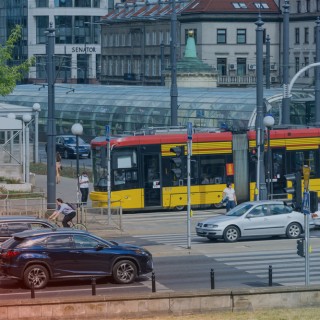FIT FOR 55 - what will the package contain?
Insights
On 14 July, the European Commission will publish the Fit for 55 package consisting of several legislative proposals. This will officially launch the discussion on measures to achieve the interim EU climate neutrality target, i.e. a 55% reduction of CO2 emissions compared to 1990. Before these rules finally come into force, they have to be accepted by EU member countries (i.e. the Council) and the European Parliament. The negotiations will take at least a year, most likely - two. The changes will not be law until 2024, but it is high time we considered how to implement them for the benefit of the climate and the economy.

No stone unturned and a higher level of ambition
The package is a result of the adoption of the European Green Deal in December 2019 and the higher emissions reduction target of 55% (by 2030) one year later by all EU countries. To achieve climate neutrality in 2050, CO2 emissions in all areas of economic life must be reduced. So far, however, emissions are still rising in some sectors (transport), and where progress has been made, the pace has not always been satisfactory (heating, industry). If the transformation is to follow schedule, we require mobilisation in all areas, more ambitious efforts and consistent implementation. The current regulations do not guarantee this and therefore needed to be changed.
Fit for 55 leaves no stone unturned. The rules of the game will change for electricity, buildings, heating, transport, industry, agriculture and forestry.[1] Where efforts to date have failed to achieve the interim target, legislation is setting new goals. It is also worth remembering that the European Parliament passed a climate law in April that requires a target for 2040. This means that Fit for 55 is just one step on the path to neutrality, and we can expect another package in the second half of the decade.
Cut emissions or pay
Tools used for mobilising to real changes are at the centre of attention. Some of them will take the form of rules, norms and standards (e.g. emissions from new cars), many - of price mechanisms. The experience of the EU ETS clearly shows that increasing the cost of high-emission solutions[2] effectively encourages their reduction.
For manufacturers, this means incentives to develop an environmentally-friendly product portfolio and to invest in low-carbon technologies. For consumers, it means that the choice of high-emission solutions will either be impossible (norms) or the costs of emissions will be included in the price. However, certain decisions will remain in the hands of the government. Lack of changes to the energy mix, lack of support for higher energy efficiency or skilled workers shortages will result in higher prices for consumers and lower competitiveness of Polish companies.
Big challenges and big support
Change is inevitable and key decisions can no longer be delayed. For a lagging country (such as Poland), the energy transition will be challenging, but European funds and support mechanisms funded by the EU ETS (see here) should provide significant assistance. Poland will be one of their biggest beneficiaries. Well used, the money should allow Polish households to become resilient to further price increases, companies to introduce technological changes and find new market niches, and the government to mitigate social risks.
Fit for 55 - key changes for Poland
-
Revision of the EU Emissions Trading System
One of the most important changes in the package is the revision of the EU Emissions Trading System (EU ETS). The mechanism has in recent years led to a significant reduction in emissions from electricity and heat production and partly from industry (by 35% since 2005, source: DG CLIMA). Nevertheless, the EU is still far from its 2030 targets. They can be achieved by reducing the number of allowances. Shipping will most likely be included in the ETS mechanism. District heating will be covered by pricing entirely - either under the reformed ETS or so-called mini-ETS (see below).
In addition, the package envisages the expansion of the Modernisation Fund, a redistribution mechanism for countries with the most difficult starting position. All revenues from allowances are to be used for energy transformation (including compensation for energy-intensive industries).
What does this mean for Poland?
The Polish energy sector must cut emissions, otherwise energy production will become increasingly expensive. Industries particularly vulnerable to increases in allowance prices should be supported in their low-emission investments with money from the ETS system. All revenues from CO2 allowances should be earmarked for industrial and energy transformation. During the transitional period, we should establish a social fund for households particularly exposed to sudden increases in energy prices.
-
Carbon emission pricing in new sectors
The ETS mechanism has proved to be effective in encouraging emission reductions in the sectors it covered. For this reason, the EC proposal will include a similar mechanism for trading CO2 emission allowances for buildings and transport (mini-ETS). It will be introduced gradually; according to the plan, it would be an auction mechanism without free allowances. The system will automatically include smaller heating plants not yet participating in the EU ETS. Pooling transport and buildings might be challenging, as unit decarbonisation costs differ. The directive enlarges the Modernisation Fund, extends it to deep thermal modernisation for medium and low income households and obliges governments to create support plans for most vulnerable ones.
What does this mean for Poland?
For a country where one in three cars is over 20 years old and the vast majority of homes are energy inefficient, factoring in the cost of emissions from transport and buildings will be a major challenge. At the same time, it is an opportunity to improve air quality, raise energy standards in buildings and develop electromobility. It is worthwhile for Poland to apply for separate emission pools for transport and buildings in order to avoid drastic cost increases for coal-fired houses. Establishing a predictable price corridor and planning the process over time will make it possible to avoid sudden price increases. It will also be important to develop regulations for biomass. The situation of the vulnerable groups must be monitored and the necessary support should be provided so that emissions pricing does not exacerbate energy poverty. It will be impossible to achieve environmental targets without investment, though. They can be financed from the European funds, although high prices of construction materials and limited availability of skilled workers may be risk factors.
A proposal for carbon pricing in new sectors, which addresses the problems of countries with a difficult starting position, can be found in the report The cost of carbon-free buildings and transport (Forum Energii, 2021).
-
Higher RES and energy efficiency targets
Raising the emission reduction goals requires adjusting the share of RES in final energy consumption and increasing energy efficiency. In the Fit for 55 package, these areas will be defined in the amended RED II and EED directives. The share of RES in 2030 will most likely increase from planned 32% to 38-40%. The energy efficiency target will increase to around 38-39% in 2030 from the current level of 32.5%.
What does this mean for Poland?
Despite some acceleration in recent years, Poland is still lagging in the use of RES in final energy consumption. This will make it even harder to achieve the 2030 targets. For transport and heating, it means that more effort will have to be put into the production and use of biomethane and green hydrogen (see here). For distributed technologies, on the other hand, complementary expansion of grid and storage capacity will be crucial. Large restrictions will be placed on the use of biomass (especially from forests), which may affect investment strategies in district heating and energy production.
To date, Poland's progress in improving energy efficiency also remains modest. In order to achieve the goals set for 2030, it will be crucial to carry out mass deep thermal modernisation of buildings, invest in equipment with highest energy standards and pursue a strategy of sector integration. It is important to note, however, that the amendment to the EED as proposed by the EC narrows the definition of an efficient district heating system, which will affect the access to funds for modernising district heat grids.
-
Carbon Border Adjustment Mechanism (CBAM)
The need to protect EU industry has been raised for over 10 years by many critics of the ETS system (including Poland). Limiting the pool of free allowances while raising their prices would put EU industry at a competitive disadvantage vis-à-vis non-EU emitters (primarily Russia, Belarus, China and India). The CBAM is supposed to level the playing field for EU producers. However, there are many doubts arising, inter alia, from consistency with WTO rules and the risk of excessive support for European entities. Therefore, the EC proposal will cover only selected products, including cement, steel, electricity, aluminium and fertilisers. Revenues from CBAM are to become one of the first ever EU own revenue sources.
What does this mean for Poland?
The introduction of CBAM should effectively counteract the leakage of emissions outside the EU, but it does not relieve Polish companies from the need to invest in low-carbon solutions to compete effectively with EU entities. The devil is in the details, and these are still unknown. Additionally, the rising costs of products such as cement, steel and aluminium may become a barrier to achieving neutrality in buildings.
-
More restricted emissions standards for new cars
One way to reduce transport emissions will be to decarbonise new cars. It is assumed that in the EU passenger car manufacturers' portfolio emissions should fall by 37.5% by 2030 compared to 2021 (2021: 95g CO2/km), and among vans by 31% (2021: 147g CO2/km). The EC proposal also provides for the introduction of a mechanism to accelerate the replacement of the car fleet with zero- and low-emission vehicles.
What does this mean for Poland?
Transport emissions are steadily rising, so transforming this area is becoming increasingly important. Restrictive emission standards complement carbon pricing in transport. Given the age structure of cars on Polish roads, changes in emissions will be slow. However, Poland plays a significant role in automotive supply chains - cars and car parts are important export goods. The ability to replace the withdrawn lines of production of high-emission cars will be an incentive to develop new market niches.
Summary
The shape of the Fit for 55 package leaves no doubt that the determination for the EU to achieve climate neutrality in 2050 is strong. It contains a structured approach to the transition and high ambitions, as well as pricing mechanisms that handsomely rewards the abandonment of carbon-intensive technologies. It is worth remembering, that Fit for 55 is a proposal for discussion. Solid arguments can help take into account Poland's specific position and mitigate the costs of the transition. Planning for efficient use of the record amount of money from the EU and the EU ETS will be the best argument that Poland takes climate policy seriously and is worth supporting. A successful investment plan will help to raise the competitiveness of the Polish economy and prevent energy poverty.
Author: Sonia Buchholtz, PhD
Collaboration: Forum Energii team
Publication date: 13 July 2021

